We drummers maintain that the drum set was the defining invention of the 20th century. By the Roaring ’20s, the marching drums borrowed from the parade ground were taking center stage in the outrageously syncopated new music called jazz. Imagine the sense of excitement and of sheer anticipation!
It was clear something really special was happening. And in that Jazz Age, the American makers Leedy, Ludwig, and Slingerland pulled out all the stops and produced drums during the later ‘20s and early ‘30s that were visual showstoppers, their stunning beauty unsurpassed to this day.
In this swift chronological run-through, we’ll pick out some of the major changes in finish options that drummers have enjoyed—or tolerated—since then, through to the almost limitless possibilities available today.
Tasteful Furniture
Leedy was an early frontrunner, and its turn-of-the-century drums were made from solid walnut or mahogany. They were crafted pieces with the staid looks of fine furniture or classical stringed instruments. But this was showbiz, and following the misery of Word War I and the Spanish Flu pandemic, drum-making pioneers quickly realized their designs should reflect the sheer delight of the new music.

Drums with extravagantly colored finishes really got going around the middle of the ‘20s. Leedy offered its metal snare drums in black or white enamel from 1924 and the following year extended the look to its wood-shell drums. But this was just a prelude. Ulysses Leedy and his visionary sidekick George Way introduced many firsts in the development of the drum set, and Way is credited as the first to wrap drums in colorful plastic—of which more shortly.
The perennial favorites (White) Marine Pearl and Black (Diamond) Pearl sat alongside shocking Red and Black Onyx and exquisite Rainbow Pearl. Ludwig was hot on the heels of Leedy with Peacock Pearl, Emerald Green, Marble Pearl, Lavender Pearl, and Turquoise Blue.
The erstwhile banjo company Slingerland moved firmly into the drum business in 1928 and immediately joined the fray with equally exciting options, including Opal (Peacock), Sea Green, and the Coral Pearls, alongside many others. The less popular and short-lived of these finishes are now mega rare and very collectable.
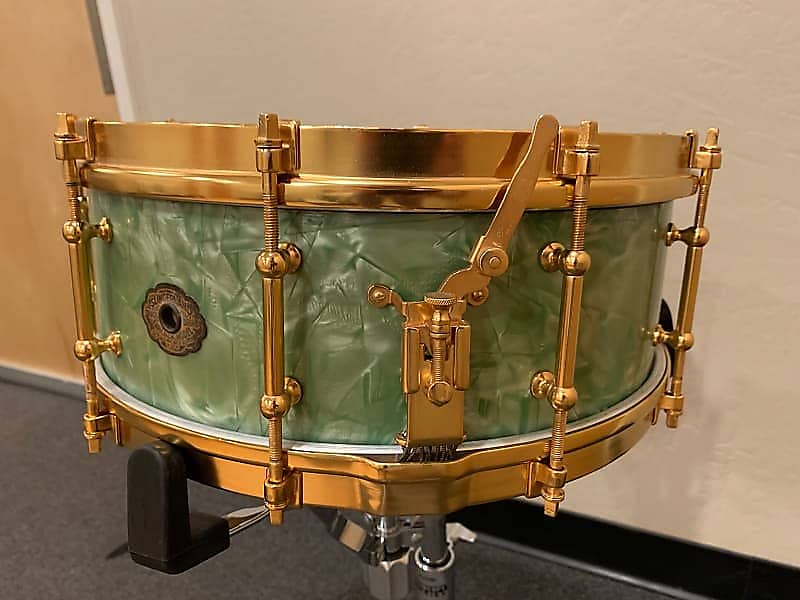
Sparkle finishes, too, first appeared around this time, and it was common for makers to take decoration further still by sticking diamonds of multicolored sparkles on to the basic finish. It was a carnival of color. But it didn’t stop there. The monster 28-inch bass drums of the time were fronted with skins handpainted by factory-employed artists, often depicting romantic Alpine scenes. Then, electric lights were placed inside the drum shells—to warm up the animal hides—creating a magical stage presence.
Such was the novelty of these inventions that they were referred to universally as Full Dress finishes. Yet this is still only half the story. The most celebrated of ‘20s drums are the brass-shelled snares, which remain at the pinnacle of the maker’s craft. The most desirable are the exquisitely hand engraved drums, notably the black-nickel-plated brass ones with intricately patterned panels. Today we often bracket these together under the evocative title Black Beauties, whether made by Leedy, Slingerland, or Ludwig.
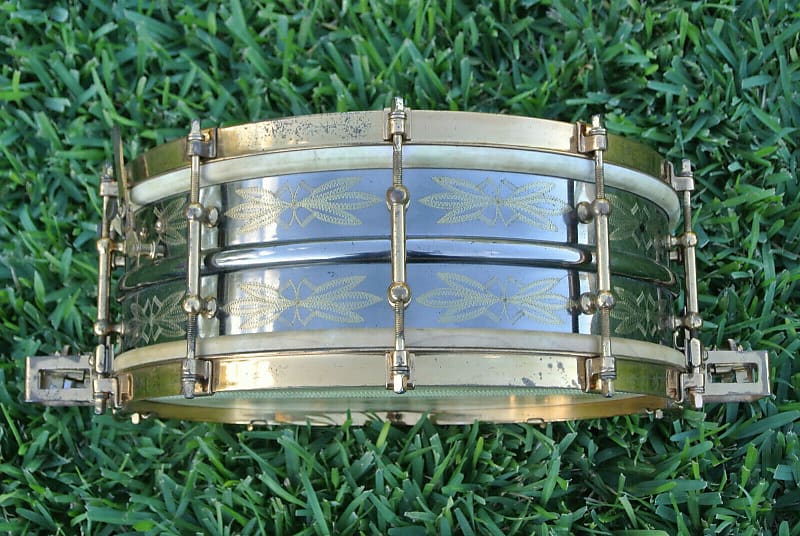
As well as the shells, the brass hoops, too, were often engraved and resplendently finished with lacquered imitation Art Gold (Slingerland) or Nobby Gold (Leedy). Remarkably, a few snare drums were plated entirely in 24-carat gold. Ludwig called its version the Triumphal models, which seems a fair description.
Contrasting Colors
Meanwhile, paint technology paralleled developments in the world of plastics. The ‘20s saw the rise of the automobile industry, and the chemical giant DuPont sped up production lines with new-fangled spraying techniques. Drum makers took up this new expertise, which enabled satin-smooth shell finishes and the ability to fade colors in and out seamlessly. Twin-color fades appeared in Blue-Silver, Black-Gold, and more.
Like many drummers, as a kid I assumed the term DuCo was a contraction of Dual Color, but in fact it derived from DuPont Color, acknowledging the supplier of the paint. DuCo dark-light-dark shell fades were popular through to the ‘50s, but thereafter they began to look old fashioned and were demoted to student-line drums. Only in recent years have multi-colored fades and bursts become attractive again, now as high-end adornments and often with sparkling finishes.
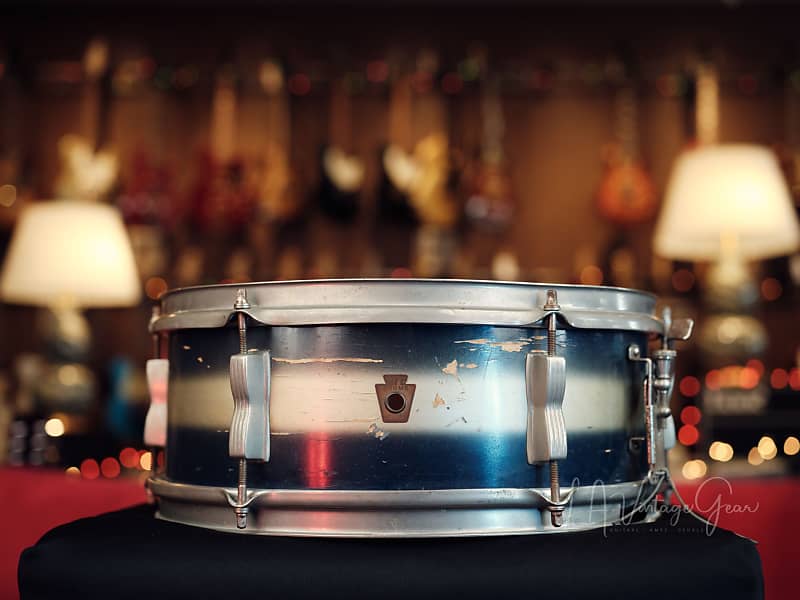
Let’s get back to those early plastic wraps. They were made from nitrocellulose (aka Celluloid) and DuPont used the brand name Pyralin, from pyroxylin, another type of nitrocellulose. The pyro prefix is a bit of a giveaway: these products are flammable—which is not too clever when confined to fiercely hot stages with drums sporting internal lights.
Indeed, the flammable nature of Celluloid, used in film work and wartime aerial reconnaissance, led to the development of flame-resistant alternatives, including the Mylar used for plastic drum heads. Inevitably, drum production was severely reduced in World War II, as were the fancy finishing options. It took some years to get back on track, but in the meantime, Celluloid was slowly being replaced by safer acetate.
Today, drum makers use a wide range of plastic materials, and without getting bogged down in industrial chemistry, it’s handy to know a little of how the numerous pearls, sparkles, and glitters are differentiated. Ready?

Mazzucchelli in Italy and Delmar in the USA are leading suppliers to all the famous drum companies. This explains the similarity in many wraps, although they may have appeared with different names in various catalogs over the decades. Classic wraps were of three types: pearls, sparkles, and glass glitters. That last one is exactly that—crushed glass suspended in a colored substrate. The glass particles have ranged from fine to more pronounced and gratifyingly lumpy (as with Rogers, Gretsch, Premier).
Sparkles are formed from three layers: a backing, the sparkles themselves, which are mostly silver flakes, and a colored overlay that transforms the sparkle to the nominal color—red, green, blue, and so on. Silver sparkle simply has a clear top layer.
Pearls were traditionally sliced from a large block of plastic materials. In the classic process, the plastic is melted to a liquid in a large tank, and then differently colored plastic pieces are stirred in until the desired pattern is formed. That provided the striated pattern of Oyster Pearls (from various makers with various names) or the raked zigzags of Slingerland’s Agate and Tiger Pearls.
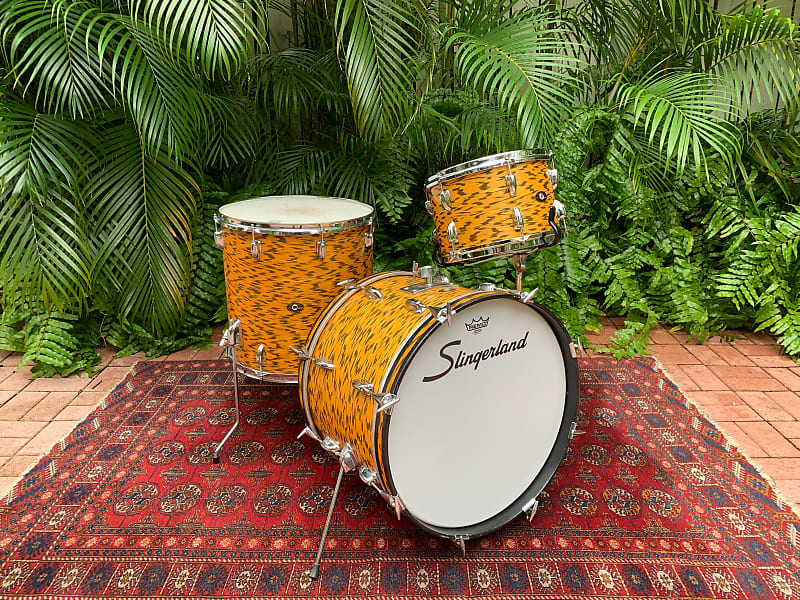
The nature of this hands-on process explains why no two examples of wrap are identical—and also why it has been impossible to re-create precisely some of the original antique designs. Once the material has cooled down, it can be sliced into thin sheets, which just happen to be 54 inches by 24. Not really the ideal size for large bass drums, but Mazzucchelli evidently has no intention of enlarging its molds just for drummers.
The Second Classic Era
Because of Gene Krupa and Buddy Rich, so-called White Marine Pearl was by far the most popular drum wrap until the advent of rock’n’roll. With the prosperity and outrage of the ‘60s, classics returned and were joined by psychedelic headache-inducing newcomers.
Ludwig’s famous Psychedelic Red, Mod Orange, and Citrus Mod Pearls were added to the Satin Flames of Gretsch, Slingerland, and Camco. These latter were made from polycarbonate sheets holding little prisms of light, which gave a 3D effect. Unfortunately, though, they’re prone to scratching and cracking.
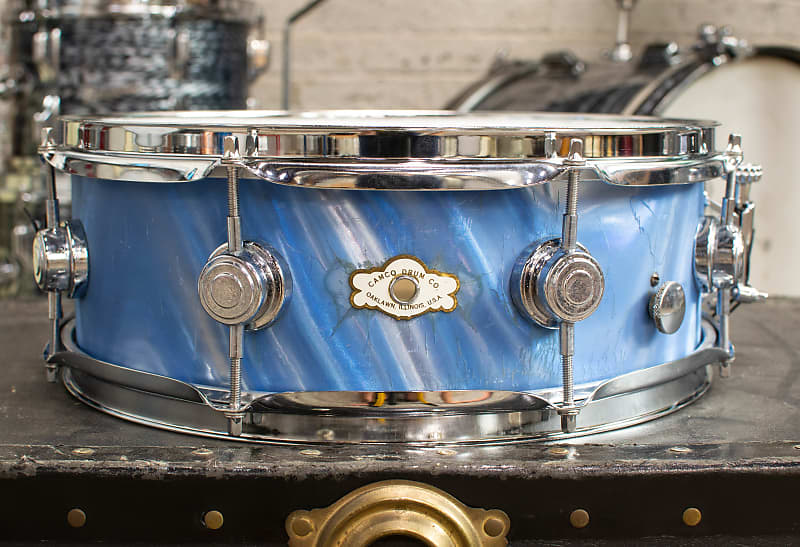
The ’60s—and into the ’70s—was also the time of chrome and copper (Slingerland) cladding, heavy fiberglass (Fibes, North, Staccato, Pearl), and see-through acrylic Plexiglas (Zickos, followed by everybody else). Ludwig went overboard with its Plexiglas Vistalite drums, which eventually offered multiple choices of patterns and color combinations.
The ‘70s OAPEC oil crisis and new health and safety regulations combined to bring these exotics to an abrupt end. The later ‘70s downfall of prog rock in favor of down-to-earth punk was the final straw. Punk drummers would not be seen dead with hippy psychedelic finishes. Plain black returned.
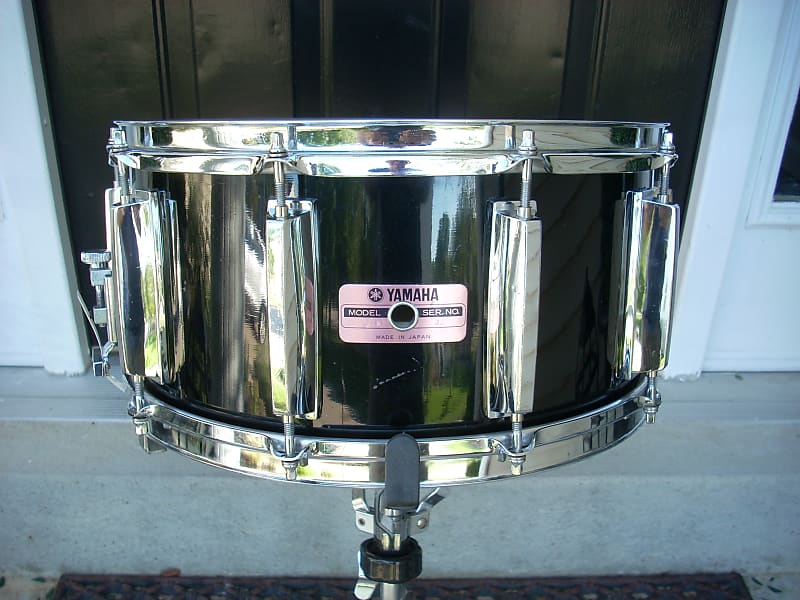
Hot on the heels of punk came the Asian revolution. Earlier Japanese "stencil" copy-kits had sported gaudy—some might say tasteless—wraps that today have a growing kitsch appeal. But the serious movement was started by Yamaha with its Recording Custom series, impeccably finished in Piano Black lacquer.
It struck me as a brilliant marketing stroke when Yamaha convinced drummers that birch was the best wood for recording, that plastic wraps were stifling their drums, and that block-color lustrous lacquering was the only sonic choice. It was hard to argue with Steve Gadd as their front guy.
Out went all the wraps to be replaced by solitary black, green, yellow—and grey. Transparent stains followed in the ‘80s, still in single hues. And with the emphasis on specific timbers, natural finishes gained popularity throughout the ‘90s. The introduction of exotic hardwoods, from bubinga to jarrah to zebrawood, heralded the boutique and custom era of high-end drums, rubbed with oils and waxes, and maybe even French polished.
Today we’re in a world of, frankly, too much choice. A glance at Delmar’s site reveals boundless options employing flexible materials that range from the classic acetates to PVC and Sicobloc, not to mention TPU (thermoplastic polyurethane) and ABS (acrylonitrile butadiene styrene, of course). The catalog’s Pantone color chart promises the minutest of tinting subtleties, while any graphic design is possible.
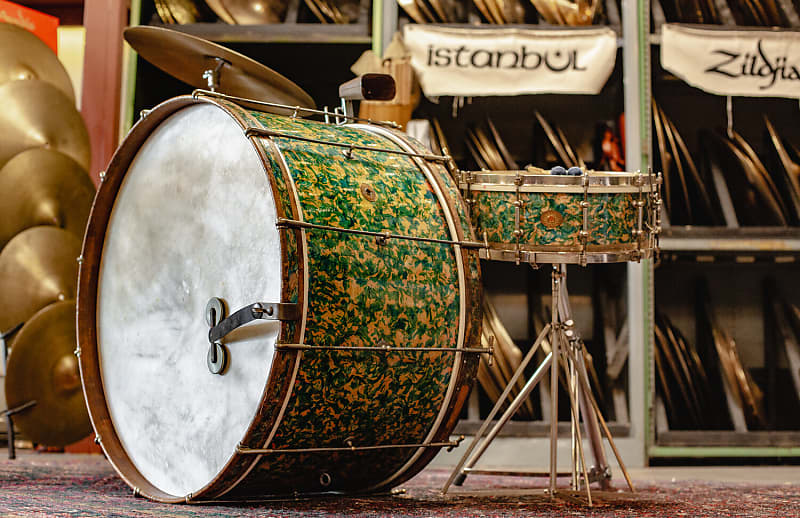
The latter-day kits of Neil Peart represented a benchmark for eye-catching extravagance. But for some, even they pale alongside ‘20s Peacock Pearl and ‘30s Silver Butterfly Wing.
About the author: Geoff Nicholls is a musician, author, journalist, and lecturer based in London. He played drums on BBC2 TV's award-winning Rockschool in 1984 and 1987 and wrote Byte The Music for BBC Radio 3, which won first prize at the New York Radio Festival in 1994. His books include The Drum Book: A History Of The Rock Drum Kit (2007) and The Drum Handbook (2003), and he is a regular contributor to Rhythm magazine.
